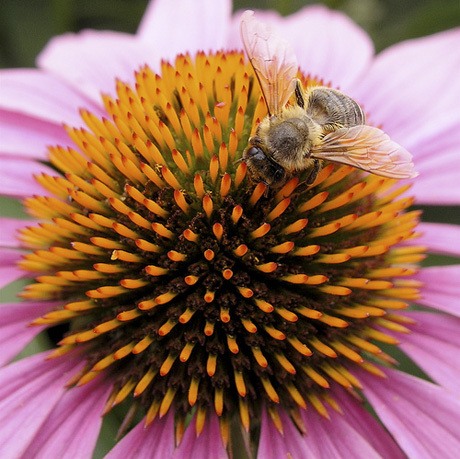This summer’s hot, dry weather inspires us to look for hardy plants that can withstand drought and still look good. One plant that will absolutely fulfill that request is Echinacea. Add to that the power to attract butterflies, hummingbirds and bees, a great honey-like fragrance, makes good cut flowers and continues to bloom for several weeks, and you have a real prize.
Echinaceas are perennials that emerge from a basal clump of leaves. The strong stems support rough, green foliage. They require full sun to mostly sunny spots in your garden and normal to sandy soil and good drainage. Their deep roots make them drought resistant, but remember to give them water during the first year until they are acclimated. Rarely disturbed by pests or disease, even deer will usually leave them alone.
Some varieties start blooming in mid-summer, and others continue the display up until the first frosts. They create attractive cone heads that will provide winter feed for small birds. The seed heads can be left on the plants for winter interest or cut for a tidier look, but you may want to stick the cones into evergreen bushes for the birds.
There are nine or so American native plants. They are widespread from Wisconsin east to the mid-Atlantic states and south through Georgia. They continue west through the Great Plains and into Texas. They have been used in medicine for at least 400 years among Native Americans. Now they are mostly used as garden ornaments.
In the past few years, breeders have created a wide variety of colors to please any pallet from native plants. Especially effective in groups of threes, the following are some that you might want to consider.
For reds and oranges, try ‘Sundown,’ which has orange petals flushed with pink combined with ‘Hot Papaya,’ a hot, bright coral orange next to ‘Tomato Soup,’ which accurately describes its color and is centered with a prominent brown cone. For true oranges, ‘Flame Thrower’ is a bright orange with a prominent brown cone boasting golden pollen grains. Combine it with the ruffed ‘Coral Reef’ that had a bright ruff around its longer orange petals or the newly introduced true double ‘Marmalade’ in golden orange.
Whites are represented by ‘Fragrant Angel,’ among others, and for a great combination, try it with the ruffed ‘Coconut Lime,’ which is white touched with green and the lovely, fully green ‘Green Jewel.’ Yellow isn’t forgotten. ‘Harvest Moon’ has a warm, golden shade. Mixed with ‘Mac ’n Cheese’, a yellow-gold, and the true, soft, yellow ‘Sunrise’ centered with a golden cone, it would make a knockout group.
Since most of the natives are pink or purple, it makes sense that there are so many pinks. ‘Hope’ has a very large, five-inch pale pink blossom with a prominent brown center and is highly fragrant. ‘Pink Poodle’ is double pastel to mid-pink and looks great with ‘Ruby Star,’ a dark, intense pink to magenta with a dark center.
Another great pink combo is ‘All That Jazz,’ which has quill-shaped petals surrounding a golden cone under laid brown. Mix it with ‘Kim’s Knee High,’ pink with a dark golden center, and ‘Pink Double Delight,’ a true pink with a highly developed ruff over reflexed petals that is among the shortest of the Echinaceas, growing only 18 to 20 inches high.
Drought and heat can’t hurt these magnificent plants. Their long-lasting vase life, sweet scent and long period of bloom all add to their value. Where will you find room for them in your garden?
I look forward to returning in the spring with more gardening tips. If you have questions until then, contact me at lindagardenlady@speakeasy.net.
Happy Gardening!


